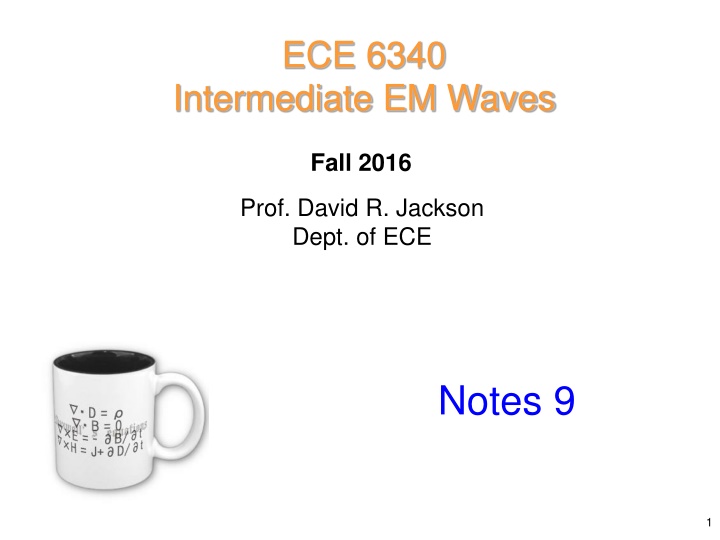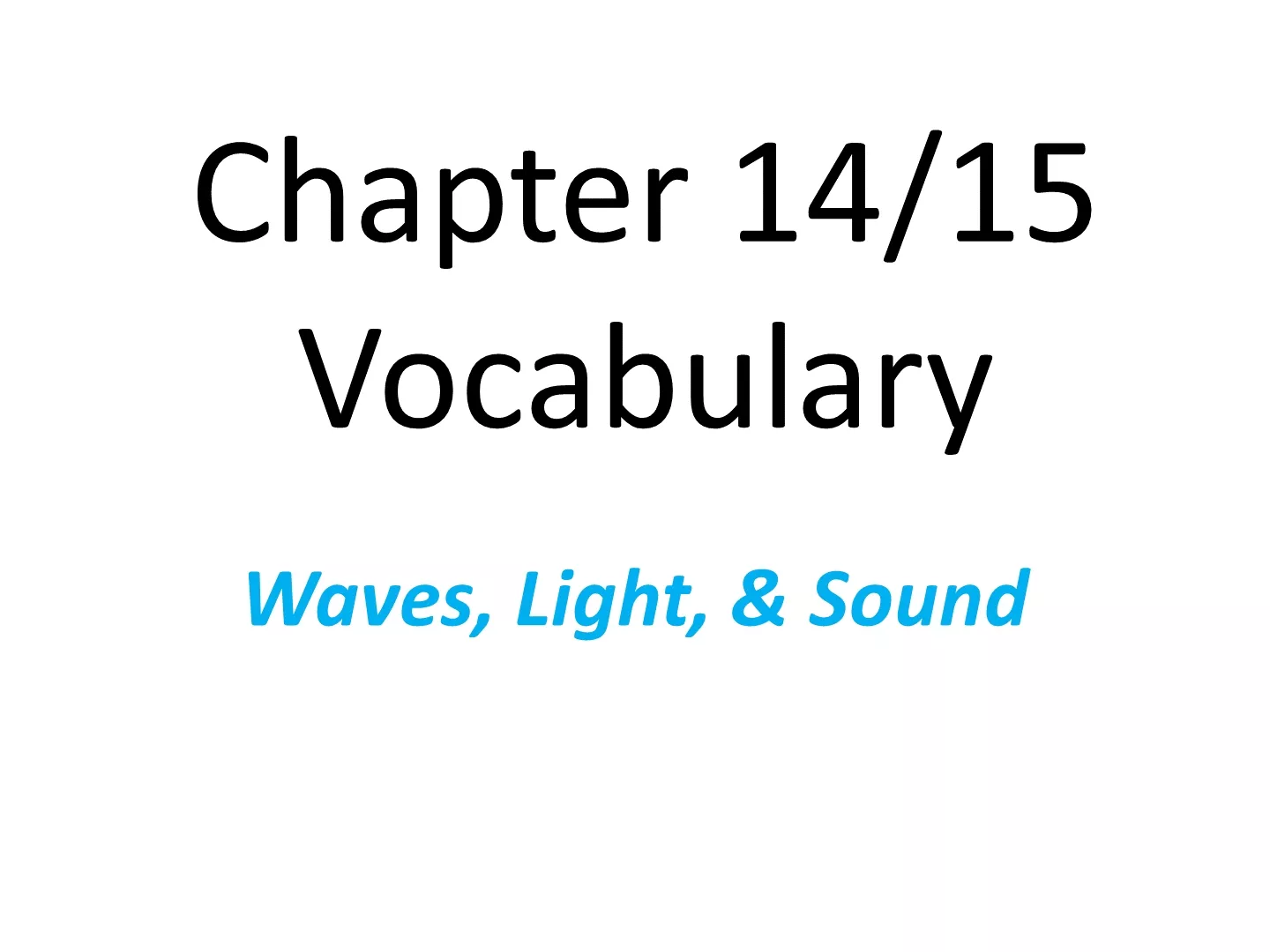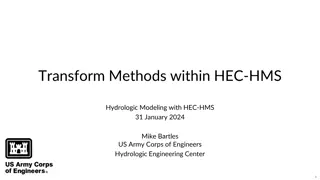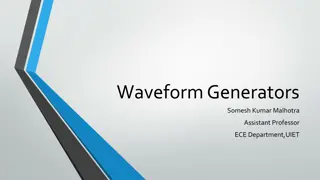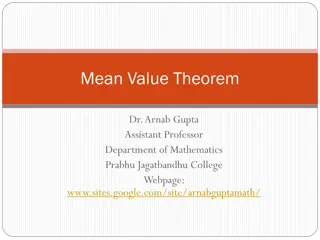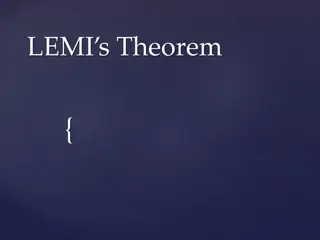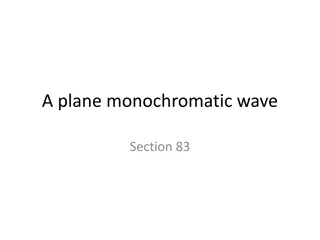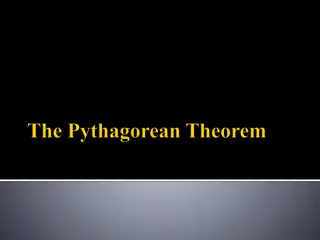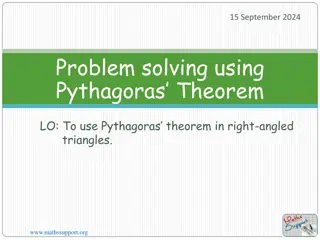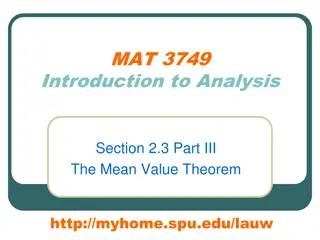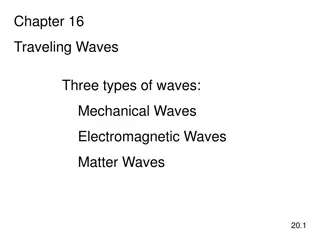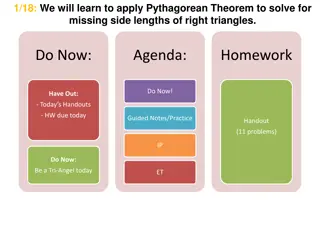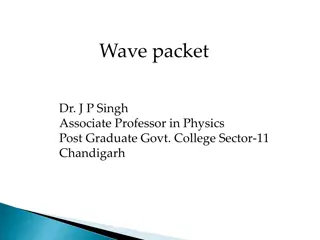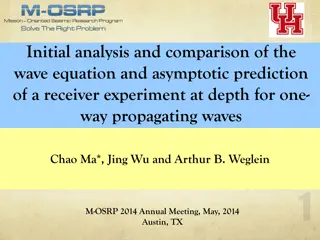Fields of a Guided Wave Theorem 9.1 Summary
Fields of a guided wave are explored and analyzed in depth, focusing on the theorem of field representation and its implications. The proof for Ey, solving for Hx, and the summary of fields in cylindrical coordinates are discussed, providing a comprehensive understanding of guided wave properties.
Download Presentation

Please find below an Image/Link to download the presentation.
The content on the website is provided AS IS for your information and personal use only. It may not be sold, licensed, or shared on other websites without obtaining consent from the author.If you encounter any issues during the download, it is possible that the publisher has removed the file from their server.
You are allowed to download the files provided on this website for personal or commercial use, subject to the condition that they are used lawfully. All files are the property of their respective owners.
The content on the website is provided AS IS for your information and personal use only. It may not be sold, licensed, or shared on other websites without obtaining consent from the author.
E N D
Presentation Transcript
ECE 6340 Intermediate EM Waves Fall 2016 Prof. David R. Jackson Dept. of ECE Notes 9 1
Fields of a Guided Wave z Theorem on Field Representation: Assume ( ) = z ( , , ) E x y z , E x y e 0 Guided wave ( ) = z ( , , ) H x y z , H x y e 0 = = ( , ) E H E E H H E H Then The t subscript denotes transverse (to z) t t z z ( , ) t t z z 2
Fields of a Guided Wave (cont.) Proof (for Ey) = H j E c 1 H H x H x = + x E z so y j z c 1 = E H z or y x j c Now solve for Hx: Need Hx = E j H 3
Fields of a Guided Wave (cont.) E z 1 E y y = H z x j 1 E y = + E z y j Substituting this into the equation for Ey yields the following result: 1 H x = E H z y x j c 1 1 H x E y = + E E z z y y j j c ( ) = 2 j j k Next, multiply by c 4
Fields of a Guided Wave (cont.) H x E y = 2 2 k E j E z z y y so + + H x E y j = E z z y 2 2 2 2 k k The other components may be found similarly. 5
Fields of a Guided Wave (cont.) Summary of Fields + H y E x j + = E z z x 2 2 2 2 k k + + H x E y j = E z z y 2 2 2 2 k k + + E y H x j = H z z x 2 2 2 2 k k + E x H y j + = H z z y 2 2 2 2 k k 6
Fields of a Guided Wave (cont.) These may be written more compactly as + + j ( ) ( ) = E z H E z z t t t 2 2 k k 2 2 + + j ( ) ( ) = H z E H z z t t t 2 2 k k 2 2 Where the 2-D gradient is defined as + x y t x y 7
Fields of a Guided Wave (cont.) In cylindrical coordinates we have 1 = + t We can thus also express the fields of a guided wave in terms of Ez and Hz in cylindrical coordinates (please see next slide). 8
Fields of a Guided Wave (cont.) Summary of Fields cylindrical coordinates + + 1 j H E = E z z 2 2 2 2 k k + + 1 j H E = E z z 2 2 2 2 k k + + 1 j E H = H z z 2 2 2 2 k k + + 1 j E H = H z z 2 2 2 2 k k 9
Types of Guided Waves = = 0 0 E H TEMz mode: Transmission line z z = 0 0 E H Waveguide TMz mode: z z = 0 0 E H TEz mode: Waveguide z z 0 0 E H Fiber-optic guide Hybrid mode: z z 10
Wavenumber Property of TEM Wave = = 0 0 E H z Assume a TEM wave: z + = 2 2 0 k To avoid having a completely zero field, = jk = k k jk = jk We then have Note: The plus sign is chosen to give a decaying wave: k z = = z jkz jk z e e e e 11
Wavenumber Property (cont.) Propagation constant vs. wavenumber notation: = = + j = = , k j jk z z k j z Note that kzis called the propagation wavenumber of the mode. j z jk z = = z jk z z z e e e e e e z z Note: = zk k TEM mode: A TEM mode can propagate on a lossless transmission line at any frequency. 12
Wavenumber Property (cont.) The field on a lossless transmission line is a TEM mode (proven later). Lossless TL: = = = zk LC k = LC so 1 LC 1 = = p v The phase velocity is equal to the speed of light in the dielectric. = v c p d 13
Wavenumber Property (cont.) Lossy TL (dielectric but no conductor loss): The mode is still a TEM mode Hence ( )( ) ( ) c c = = + j L G + j C = = = k j j R k j z c Note: The TEMz assumption requires that R = 0. Otherwise,Ez 0 (from Ohm's law). ( )( ) ( ) c c j L G + j C = j j ( )( ) ( ) c c j L G + j C = 2 j = LC Real part: c = LG Imaginary part: c c C ( ) = G Dividing these two equations gives us: c 14
Static Property of TEM Wave The fields of a TEM mode may be written as: = = z ( , , ) E x y z ( , ) ( , ) x y e E x y e 0 z E 0 t = z = = ( , , ) H x y z ( , ) x y e H jk jk 0 t z Theorem ( , ) x y and are 2D static field functions. 0 ( , ) t H x y E 0 t 15
Static Property of TEM Wave (cont.) Proof x y z = E 0 t x y z 0 E E 0 0 x y E E 0 y = z 0 x x y Therefore, only a z component of the curl exists. We next prove that this must be zero. 16
Static Property of TEM Wave (cont.) Use = = = z ( ) E E e 0 t + z z ( ) e E e E 0 0 t t z E z z e E e 0 0 t t = z z z ( ) ( ) E e E 0 t Also, = = z z ( ) ( ) 0 E j H = j H z 17
Static Property of TEM Wave (cont.) Hence ( z = ) 0 E 0 t Therefore, ( ) = , 0 t E x y 0 18
Static Property of TEM Wave (cont.) Also, = ( No charge density in the time-harmonic steady state, for a homogeneous medium) 0 E ( ) = z 0 t E e Therefore, 0 ( ) + = z z ( ) 0 E e E e 0 0 t t ( ) ( ) ( ) + = z z z 0 E e E e 0 0 t t ( ) = , 0 t E x y Hence, 0 19
Static Property of TEM Wave (cont.) ( 0 ) = , 0 t E x y ( ) = , 0 t E x y 0 ( ) = , 0 E x y 0 = t ( , ) x y E 0 t = 0 E = 0 t 2 0 20
Static Property of TEM Wave (cont.) ( ) = , ( , ) x y t E x y 0 A B = 2 ( , ) x y 0 = constant on ( =0 ) E or since on conductors A B tan The potential function is unique (because of the uniqueness theorem of statics), and hence is the same as a static potential function (which also obeys the Laplace equation and the same BCs). 21
Static Property of TEM Wave (cont.) The static property shows us why a TEMz wave can exist on a transmission line (two parallel conductors). A B V0 Transmission line A nonzero field can exist at DC. 22
Static Property of TEM Wave (cont.) The static property also tells us why a TEMz wave cannot exist inside of a waveguide (hollow conducting pipe). Waveguide No field can exist inside at DC. (This would violate Faraday's law: at DC the voltage drop around a closed path must be zero.) C 23
Static Property of TEM Wave (cont.) Similarly, = = 0 0 H H 0 t 0 t so = = ( , ) x y H 0 t m 2 0 m = 2 0 n m B A = 0 and m C C 1 2 n C ( ) 0 n = 0 H t 24
TEM Mode: Magnetic Field = H j E c x y z 1 = E j x y c 0 H H x y so = = E H E H x y y x j j c c 25
TEM Magnetic Field (cont.) Also, jk jk = = = = = c z j j j c c c c c = = E H so x y E H y x This can be written as 1 = z E ( ) H 26
TEM Mode: Current and Charge Density TEM mode n y A B x s ( ) l dl = E l s C A = CV l 1 C =capacitance / length n H = = z E n s J B = E dr V A 27
TEM Mode: Current and Charge Density (cont.) ( ) ( B C = A ( ) ) B A C C A B ( ) ( ) ( ) z E = n z n E E n z so 1 1 ( ) ( ) = n E = n D z z s J Note: = z s s J = In general Hence c c 28
TEM Mode: Homogeneous Substrate A TEMz mode requires a homogeneous substrate. y Coax partially filled with dielectric , r r Assume a TEM mode x + = + = H H E E r x x y y + E H + y + = = 0 : x BCs 0 + = E E = H H 1 x y = 0 x + r r E H r r 1 y x r y = = 0 : x 1 x Take the ratio = 1 Contradiction! r r 29
Example: Microstrip Line ( ) x J sz y w r h x = eff r k k 0 z y ( ) sx Assume a TEM mode: (requires a homogeneous space of material) r eff x h w 1 = ( ) x J sz s eff Homogeneous model 0 r 30
Example (cont.) Strip in free space (or homogeneous space) with a static charge density (no ground plane): y 1/ = ( ) x s l 2 2 ( ) ( / 2) w sx x x (This was first derived by Maxwell using conformal mapping.) w /2 w = ( ) x dx l s /2 w Hence: 1/ ( ) x J I 0 sz 2 2 ( / 2) w x In this result, I0is the total current[Amps] on the strip at z = 0. This is accurate for a narrow strip (since we ignored the ground plane). 31
Example: Coaxial Cable Find E, H We first find Et0 and Ht0 ( ) 0 , x y = ( , ) x y t E a rc = = = 2 ( ) ( ) ( ) b 0 V a b 0 0 = ( ) 1 = 0 = c 1 = c 1 = + ln c c 1 2 32
Example (cont.) Boundary conditions: + = = ln ln c c a b c + c V 1 2 0 0 1 2 so = (ln ln ) c a b V 1 0 Hence ln V V b = = = ln 0 0 c c c b 1 2 1 a b a b ln ln Therefore ln V V b V = + = ln( ) ln 0 0 0 a b a b a b b ln ln ln 33
Example (cont.) V = ln 0 a b b ln = = ( , ) x y ( , ) x y t E 0 Hence or 1 V 1 V = 0 E = 0 E 0 t b a 0 t a b ln ln 34
Example (cont.) 1 1 = z E = ( z ) H E E = H = E c The three-dimensional fields are then as follows: 1 V = jkz 0 E e This result is valid at any frequency. b a ln = k 1 V c = jkz 0 H e b a ln 35
Example (cont.) y Find the characteristic impedance. + = jkz V V e 0 + = = aH a x 2 2 ( ) I aJ sz 1 V = jkz 2 0 a e E b a a Js ln = c b a + V I = [ ] ln Z = Z 0 0 + 2 36
Example (cont.) Find (L, C)for lossless coax. = LC (assume = 0) L C= b a = Z ln Z 0 0 2 Use Solve for L and C (multiply and divide the above two equations): 2 = F/m 0 b a r C ln b a = ln H/m 0 L 2 37
Example (cont.) Find (L, C, G)for lossy coax. 1ln 2 b a = LC = lossless 0 Z c 0 c L C= lossless Use Z 0 c C ( ) = G c Result: rc 2 = F/m 0 C b a rc C ln ( ) = [S/m] G rc b a = ln H/m 0 L 2 38
TEM Mode: Telegraphers Eqs. H Cv A B i E y A B x TEM mode (lossless conductors) B E = v dr A 39
Telegraphers Eqs. (cont.) B ( ) = + E E v dx dy x y A E B E v z y = + x dx dy z z A ( ) = E E dr z ds Note: C S The voltage v is path independent in the (x,y) plane. B = ds z t S = 0 40
Telegraphers Eqs. (cont.) B = E Use t Take x and y components: E B B E E E y y = = + x x z z t y z t x z Hence, we have B B B v z y = + x dx dy t t A B ( ) = B B dy dx x y t A 41
Telegraphers Eqs. (cont.) Cv ( ) z d = = + n d xdx ydy z C v = ydx xdy n dy d C B B ( ) ( ) ( ) v = + B B B B x y ydx xdy dy dx x y x y dx A A B = = B n dl C l v But A (flux per meter) l L i = Li v z so ( ) l = Li t Hence v z i t Note: = L L is the magnetostatic (DC) value (a fixed number). 42
Telegraphers Eqs. (cont.) If we add R into the equation: v z i t = Ri L This is justifiable if the mode is approximately a TEM mode (small conductor loss). Please see the derivation in the Appendix. 43
Telegraphers Eqs. (cont.) Now use this path: Ci y The contour Cihugs the A conductor. x A B Note: There is no displacement current through the surface, since Ez=0. ( ) = = + H H H i dr dx dy Ampere s law: x y C C i i H H i z y = + x dx dy so z z C i 44
Telegraphers Eqs. (cont.) Now use D = + H J t Take x and y components: H D H y = + J x z x H H D y z t y + = + J x z y x z t 45
Telegraphers Eqs. (cont.) Hence D D i z ( ) y = + J J x dx dy dx dy y x t t C C i i ( ) ( ) = + D D J J dx dy dx dy y x y x t C C i i 46
Telegraphers Eqs. (cont.) ( ) = = + n dl xdx ydy z d z i C dx = + ydx xdy d dy n i C = D n Ci i C s ( ) ( ) = + + = = = A l D D D D D x y ydx xdy n dl dx dy dl y x x y C s l i C C C C i i i i = = J J J n dl dx dy leak i y x C i C C i i But = Cv Gv = / C G v Note: l l C and G are the static (DC) values. / leak i v leak i 47
Telegraphers Eqs. (cont.) Hence i z = Cv ( ) Gv t or i z v t = C Gv 48
Appendix ( ) ( ) H = + Alternate derivation of second Telegrapher s equation , , dr i z z t i z t i C Ampere's law: + ( , ) z t i z z d dt = + iS H J D n dS ndS dr z i C C S S n i i i ( , ) i z t d dt ( ) = leak i z d dt ( ) J = zGv z Cv Hence d dt ( ) ( ) ( ) + = , , i z z t i z t zGv z Cv i z v t Gv C = 49
Appendix (cont.) ( ) ( ) ( + ) E Include R = + + , , dr v z z t v z t R R zi 1 2 C R v Assume that current still flows in the z direction only, and R is unique in the time domain. d dt = E B ndS dr Faraday's law: C S v v z d dt i ( ) = z J l i d dt ( ) ( ) + + , v z z t = z Li Hence: #1 n v S d dt ( ) ( ) ( ) + R zi + = , , v z z t v z t z Li C z v ( ) + , v z t v z i t = Ri L #2 l= flux/meter 50
